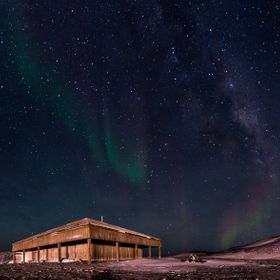

J-swanson
Follow
Panoramic taken at 2:30a.m at McMurdo Station Antarctica. We had Aurora Australis activity going on this day 08-12-2015. I thought the Milky Way and our Observa...
Read more
Panoramic taken at 2:30a.m at McMurdo Station Antarctica. We had Aurora Australis activity going on this day 08-12-2015. I thought the Milky Way and our Observation hill would make a nice image.16 images to make this single image you are viewing. 8 frames across the top and 8 frames across the bottom, original size is 14538x5657 or 82 mega pixels. Gear used, Nikon D7100, Sigma 18-35mm and a tripod with nodal alignment bracket.
Read less
Read less
Views
705
Likes
Awards
Zenith Award
Creative Winter Award
Winner in Landscape Panorama Photo Challenge
Staff Winter Selection 2015
Top Choice
Absolute Masterpiece
Superb Composition
Outstanding Creativity
Peer Award
Love it
Magnificent Capture
Superior Skill
Top Ranks
Categories
Same photographer See allBehind The Lens
Discover more photos See all
Behind The Lens
Location
This panoramic image was taken at McMurdo Station located on Ross Island, Antarctica.Time
Roughly 2:30am on 08/12/2015.Lighting
Though we are in Antarctica we still have some light pollution. Bottom right is light from McMurdo Station. In the sky to the left is Aurora Australis activity. I added no lighting to the shoot however.Equipment
Equipment used for this image was a Nikon D7100, Sigma 18-35mm lens, tripod with no parallax pan bracket and remote shutter.Inspiration
A lot of times I have a plan with the Milky Way and track when it will be where I want it. Though with this one I recall just being out and being inspired. I was worried about the light pollution from McMurdo Station but it worked out in the end I feel. The Aurora activity aided a great deal as I was looking for a composure that they added to the image instead of being the focus. Some times I find Auroras to detract from an image too, fun challenge they add as they can not be planned around and they are always changing.Editing
This image was done fully in Lightroom 6. It is a panoramic made up of 16 frames, 8 across the bottom and 8 across the top. My processing methods have evolved since this image so I do not recall what all was done in Lightroom with this one. Likely though I used the brush tool to bring out the Milky Way with the use of clarity and maybe even exposure to bring out the heart. Also used the brush to mask the sky from landscape to adjust color. Today I use Photoshop layering and masking as I have more control.In my camera bag
Depends what I am out doing. If is a Milky Way shoot I usually just have the one lens, tripod with no parallax bracket and a remote shutter. This year I added a external battery to that mix for longer life in the sub zero conditions I normally shoot in. But when traveling and playing by ear I now have a D810 and D7100 in the bag along with my lenses Sigma 20mm F1.4, Sigma 24-35mm F2, Sigma 50mm F1.4 and the Tamron 70-200mm F2.8. ND filters from 3 stops to 12 stops as I like to play with long exposures into the minutes. I also keep a sensor cleaning kit handy, not in the field but at place of stay.Feedback
This is a single focus point panoramic. The focus point was on the stars, I use the live view and pick out the brightest star and aim it in the center of the frame, zoom in and focus the star to the smallest dot. I generally shoot wide open when shooting the Milky Way, though this one I was at F2. I use a no parallax/nodal point bracket which helps with panoramic merges. With out the bracket some items may change view from the lens and not align correctly. I almost always go to ISO-3200 for the Milky Way as in a panoramic the noise becomes smaller less noticed. I also use the rule of 300 to avoid star trails for shutter speed. Example 300/18mm = 16.66 seconds so with a 18mm lens I keep the exposure 16 seconds or less. When I shoot at F1.4 Iso-3200 I am 8 to 10 second exposures. I shoot to the right a little as it is cleaner to darken an image vs adding exposure in post. I keep the camera White Balance set at 5600k and adjust in post this makes sure each frame is the same and aids in panoramic merges. Please don't get caught in rules and play around to find what works for you. I keep changing things up learning along the way. I have some Milky Way pans using a 50mm lens at F1.4 which isn't the norm but works very well in my opinion. So thanks for looking and reading, enjoy the great creative world of photography.











































